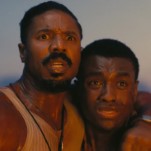Cry Havoc Vol. 1: Mything in Action is Bloody Perfect
Main Art by Ryan Kelly & Emma Price

Writer: Simon Spurrier
Artist: Ryan Kelly w/ Nick Filardi, Lee Loughridge, Matt Wilson & Emma Price
Publisher: Image Comics
Release Date: August 17, 2016
 The concept of “true names” has resonated throughout folklore and myth since before the days of biblical antiquity. Names have power. Names ascribe weight to the immaterial, form to the incorporeal, clarity to the ineffable. This power sits at the cornerstone of not only myth, but of what we commonly define as speculative fiction. And that applies to Cry Havoc Vol. 1: Mything in Action, a modern fantasy-military drama that is not about a lesbian werewolf who goes to war. Except, well, it sort of is.
The concept of “true names” has resonated throughout folklore and myth since before the days of biblical antiquity. Names have power. Names ascribe weight to the immaterial, form to the incorporeal, clarity to the ineffable. This power sits at the cornerstone of not only myth, but of what we commonly define as speculative fiction. And that applies to Cry Havoc Vol. 1: Mything in Action, a modern fantasy-military drama that is not about a lesbian werewolf who goes to war. Except, well, it sort of is.
Writer Simon Spurrier and artist Ryan Kelly’s Cry Havoc is the story of Louise Canton, a street-performing violinist-turned-lycanthropic-living-myth struggling to hold onto her humanity as she reckons with what she’s become. While wrestling with this new development, Lou inadvertently attracts the attention of a clandestine agency that promises to help her control, and ultimately extinguish, her supernatural persona. In return, she’s conscripted as a reconnaissance attaché to a special unit of similarly afflicted soldiers deployed to Afghanistan in search of a mysterious enemy. What Lou discovers through her journey irrevocably changes not only her life, but the lives of all those around her. Between the metaphorical wolves of chaos and control, the mundane and the unknown, which one will she feed?

Cry Havoc Interior Art by Ryan Kelly & Lee Loughridge
Cry Havoc’s writing delivers a wealth of whip-smart genre savviness and folkloric erudition, courtesy of Spurrier’s deft plotting and approachable dialogue. The appeal of Lou as a character is that, at some point, one has either crossed paths with someone like her or perhaps has even been her. Her perpetual joblessness, search for self-certainty and attempts to maintain close relationships resonate deeply. The balancing act of her virtues and shortcomings, her bravery and musicality juxtaposed by her flakiness and profanity, neither diminishes nor elevates her beyond the reach of approachability, but humanizes her. As with so many other great works of contemporary supernatural fiction, the cascading consequences of her condition serve as the framework through which the raw human heart of her story emerges.
-

-

-

-

-

-

-

-

-

-

-

-

-

-

-

-

-

-

-

-

-

-

-

-

-

-

-

-

-

-

-

-

-

-

-

-

-

-

-

-












































